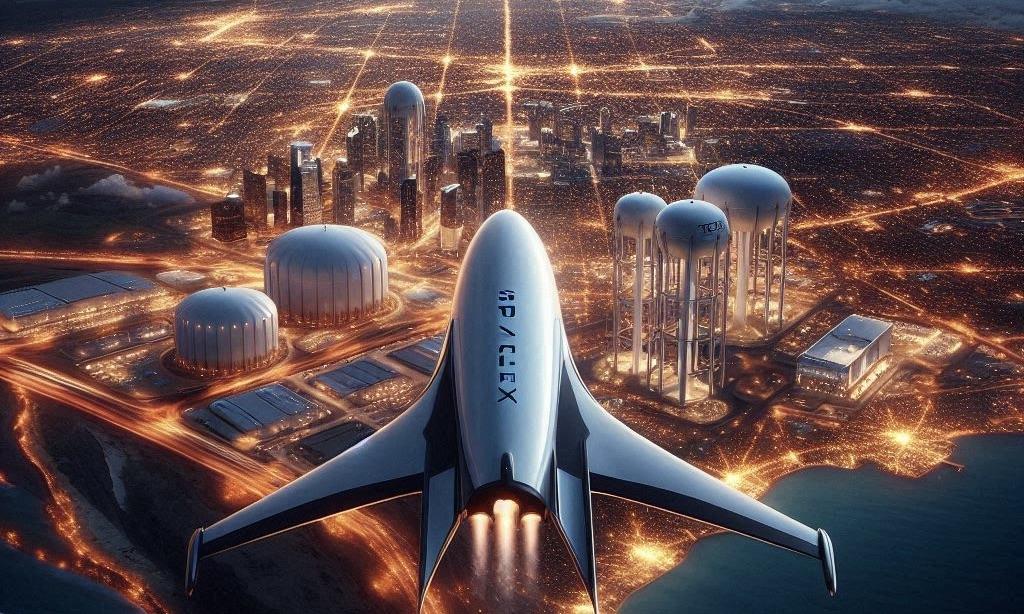SpaceX is on the verge of hitting four million Starlink customers, according to President Gwynne Shotwell. The company has invested $3 billion into Starship facilities in Texas, emphasizing the significance of Starship for its mission to Mars. SpaceX plans to launch 100 Falcon 9 missions to expand Starlink.
SpaceX Invests $3 Billion in Texas Starship Facilities as Starlink Nears 4 Million Customers
According to Gwynne Shotwell, SpaceX's president and chief operations officer, the company is on the brink of achieving a significant milestone by reaching four million customers for its Starlink satellite internet constellation. According to Wccftech, Shotwell disclosed at a hearing before the Texas House of Representatives Appropriations Committee for the Texas Space Commission earlier this week that SpaceX has allocated $3 billion to developing its Starship facilities in Texas, underscoring the significance of these investments for the future of space exploration.
The Starship, the most substantial rocket presently under development, is essential to SpaceX's objective of transporting humans to Mars. During her testimony, Shotwell disclosed that SpaceX intends to launch 100 Falcon 9 rockets as part of its ongoing endeavors to expand the Starlink satellite network. This increased launch cadence aligns with the company's efforts to construct a portion of the Starlink constellation capable of providing direct smartphone coverage via satellite.
Shotwell initiated her remarks by emphasizing SpaceX's substantial presence in Texas, which encompasses a one-million-square-foot facility exclusively dedicated to producing Starlink terminals. The company is extending its facilities in response to the increasing demand for Starlink. In 2023, SpaceX entered into agreements with numerous airlines to integrate Starlink, extending the service's global reach. Shotwell verified on September 24 that SpaceX was on course to surpass four million Starlink customers. The company officially announced on September 26 that it had achieved this milestone.
SpaceX Plans 100 Satellite Missions to Expand Starlink and Advances Starship Development in Texas
According to Shotwell, SpaceX anticipates launching approximately 100 missions to install an additional 100 satellites in orbit to facilitate the rapid expansion of the Starlink constellation. This expansion aims to offer high-speed internet access to underserved communities worldwide and rural areas in Texas.
Starlink is a critical component of SpaceX's overarching objective to finance the development of Starship, which is currently being constructed in Boca Chica, Texas. The next test flight is scheduled for late November, and Starship has flown four times. According to Shotwell, the Starship complete stack, which includes both rocket stages, can deliver more than 150 metric tons to Earth orbit. She emphasized that the Starship development facilities, also known as Starbase, are unparalleled in their capacity to manufacture, test, and launch the most advanced rockets in the world. Over the past few years, SpaceX has allocated over $3 billion to these operations, with $1 billion allocated to Texas in the past year.
Additionally, Shotwell furnished updates regarding the production of SpaceX's Starlink user station in Bastrop, Texas. She disclosed that SpaceX's objective is to compete with Taiwan and other Asian nations in producing printed circuit boards for the Starlink user terminals. She further stated, "Bastrop will be the largest printed circuit board manufacturing facility in the entire United States," and expressed her confidence that SpaceX could surpass Southeast Asia in production efficiency.
Several modifications have been made to the rocket as SpaceX prepares for the fifth Starship test flight in Boca Chica. These modifications include repeatedly testing the tower capture arms, designed to recover the booster after flight, and upgrading the upper stage heat shield. These arms will endeavor to capture the Super Heavy booster upon its return. If successful, subsequent tests may involve the second stage of Starship returning to the launch site.



 Anthropic Launches HIPAA-Compliant Healthcare Tools for Claude AI Amid Growing Competition
Anthropic Launches HIPAA-Compliant Healthcare Tools for Claude AI Amid Growing Competition  xAI Cash Burn Highlights the High Cost of Competing in Generative AI
xAI Cash Burn Highlights the High Cost of Competing in Generative AI  BTIG Initiates Buy on SoftBank as AI and Robotics Strategy Gains Momentum
BTIG Initiates Buy on SoftBank as AI and Robotics Strategy Gains Momentum  Cogent Biosciences Soars 120% on Breakthrough Phase 3 Results for Bezuclastinib in GIST Treatment
Cogent Biosciences Soars 120% on Breakthrough Phase 3 Results for Bezuclastinib in GIST Treatment  Trump Administration to Launch Autism Initiatives Targeting Acetaminophen Use and New Treatment Options
Trump Administration to Launch Autism Initiatives Targeting Acetaminophen Use and New Treatment Options  CDC Vaccine Review Sparks Controversy Over Thimerosal Study Citation
CDC Vaccine Review Sparks Controversy Over Thimerosal Study Citation  NASA Resumes Cygnus XL Cargo Docking with Space Station After Software Fix
NASA Resumes Cygnus XL Cargo Docking with Space Station After Software Fix  FDA Adds Fatal Risk Warning to J&J and Legend Biotech’s Carvykti Cancer Therapy
FDA Adds Fatal Risk Warning to J&J and Legend Biotech’s Carvykti Cancer Therapy  China Reviews Meta’s $2 Billion AI Deal With Manus Amid Technology Control Concerns
China Reviews Meta’s $2 Billion AI Deal With Manus Amid Technology Control Concerns  SK Hynix Shares Hit Record High as AI Memory Demand Fuels Semiconductor Rally
SK Hynix Shares Hit Record High as AI Memory Demand Fuels Semiconductor Rally  Samsung Forecasts Strong Q4 Profit on AI-Driven Memory Chip Boom
Samsung Forecasts Strong Q4 Profit on AI-Driven Memory Chip Boom  AMD Unveils Next-Generation AI and PC Chips at CES, Highlights Major OpenAI Partnership
AMD Unveils Next-Generation AI and PC Chips at CES, Highlights Major OpenAI Partnership  Hyundai Motor Shares Surge on Nvidia Partnership Speculation
Hyundai Motor Shares Surge on Nvidia Partnership Speculation  Baidu’s AI Chip Unit Kunlunxin Prepares for Hong Kong IPO to Raise Up to $2 Billion
Baidu’s AI Chip Unit Kunlunxin Prepares for Hong Kong IPO to Raise Up to $2 Billion  Blue Origin’s New Glenn Achieves Breakthrough Success With First NASA Mission
Blue Origin’s New Glenn Achieves Breakthrough Success With First NASA Mission  Mercedes-Benz to Launch Advanced Urban Self-Driving System in the U.S., Challenging Tesla FSD
Mercedes-Benz to Launch Advanced Urban Self-Driving System in the U.S., Challenging Tesla FSD 































